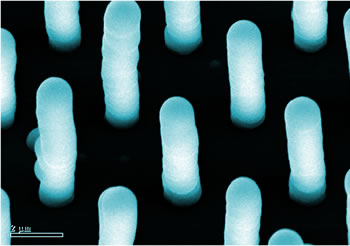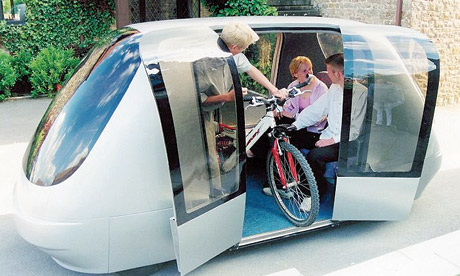First mooted over a century ago, personal rapid transit systems might soon be running through our cities
When Heathrow Terminal 5 opens next year, a network of up to 18 driverless pods will ferry people between the main terminal and its car parks, where each pod will be controlled by an internal computer and onboard sensor systems.
Welcome to the pioneering world of personal rapid transport (PRT) - a feasible technological solution to the chronic problem of traffic congestion, offering public transport with the privacy of a car.
Basically, a driverless four-seater vehicle (call it a podcar if you like) that automatically runs on a guideway over a dedicated network, lighter than light rail and running on a fraction of its energy, PRT has been the ambition of a select group of engineers since the late 1950s. But only now are the first networks being constructed.
Heathrow's network is admittedly modest: just 3.5km (2.2 miles) of guideway will connect car park and terminal. But it is the first public test of its kind. BAA has indicated that if the pilot is successful, it will extend PRT throughout the airport.
PRT is not just a very short bus or train. For starters, there is no timetable. Instead, visitors to a PRT network should find pods waiting for them, making it more like a taxi rank than a bus stop. According to Advanced Transport Systems (atsltd.co.uk), the Bristol-based company behind Ultra, the maximum waiting time at a terminal will be just 12 seconds. The second difference is that there are no stops: the pod will not pick up further passengers along the way, and there are no traffic lights to contend with. Finally, the pod is as private as a taxi, so you are always guaranteed a seat, even in peak hours.
Once inside the pod you pick your destination and travel at about 20mph. On alighting, the pod waits for the next fare or is automatically rerouted to where there is most demand. As Russell Goodway, the former lord mayor of Cardiff once put it, PRT is "public transport that is waiting for you, rather than you waiting for it".
Environmentally driven
PRT was conceived in the 19th century, but it was the American Donn Fichter who began seriously pushing the idea with his book, Individualized Automated Transit and the City, in 1964 - although he says the idea was based on work going back to 1953 (see below). The UK planned extensive PRT networks for Birmingham and central London until 1971. Equivalent projects in France, Germany, Sweden, Japan and the US began in earnest before being commercially derailed.
Now, environmental concerns are driving a revival of interest. According to Advanced Passenger Systems, each vehicle uses just a quarter of the energy per passenger mile of a car. Some proponents predict PRT could be run on renewable energy, such as solar. But even with conventional electricity, Ultra remains attractive because its exhaust emissions are effectively zero.
Soon, work on the guideway begins at Heathrow, with the first paying passengers expected in a little over a year. Last month the company took possession of its first production vehicle, and its inventor Martin Lowson, a former rocket scientist who worked on the Apollo space programme, is excited that a project he undertook in the mid-90s is finally reaching fruition. "The trouble with our cities," he says, "is that they have been designed around the car for the last 50 years or so."
PRT is good for a closed network such as an airport, but there are indications that it could soon wend its way into our towns and cities. Several local authorities are looking closely at PRT, and the one furthest down the line is Daventry in Northamptonshire. Its population of 23,000 is set to expand to more than 40,000 by 2021 as part of the government's strategy to build lots of new houses within striking distance of London.
"Currently less than 3% of trips made within the town are by public transport," says Simon Bowers, an officer at Daventry Council. "Our studies have shown that to get people on the buses, we'd have to put on so many extra ones that we'd miss our sustainability targets."
Several Gulf states are thought to be developing PRT systems, as are the French. But the Dutch have hit an unexpectedly bumpy ride. Earlier this year, 2getthere (2getthere.eu), which was developing a driverless shuttle bus in Rotterdam, filed for bankruptcy.
Network problem
Even so, the obvious problem with PRT is not the development of the vehicles, but the building of large networks of guideways. At between £3m-£5m per mile, the network is expensive, although that compares favourably with light rail.
In terms of capacity, PRT is expected to be at least as efficient as a stretch of motorway, but less efficient than a mainline railway. Lowson says the solution in city centres is to build overhead. But for the near future at least, PRT is likely to be developed as a complimentary transport, ferrying people around airports or large campuses.
After the UK, the most developed market for PRT is in Sweden. Two rival systems are competing to build networks in Swedish cities. Posco, a Korean company, is developing a system in Uppsala, while the Stockholm-based Skycab (skycab.se/eng) is planning three, including Arlanda airport, a university campus in Stockholm and the small town of Hofors.
Ake Aredal, Skycab's founder, thinks this generation of PRT is much more likely to succeed. "Previously, PRT systems were led by engineers," he says, "whereas this time we are letting the market drive it. We have to build a system that people actually want. One that's convenient and safe and fits in around their life."
The big test, then, is not technological. Several PRT systems have already proved to be technically competent. The challenge is getting people to accept such a futuristic mode of transport and making them actually use it. Only then will the age of the podcar have finally arrived.
Personal Rapid Transport: the story so far
1953: Donn Fichter, a New York city transportation planner, begins research on personal rapid transport (PRT).
1967: Len Blake at the British Electrical Company begins developing Cabtrack, which planned a network of overhead guideways for Birmingham and central London. The project is shelved in 1972 due to cost and visual intrusion.
1967: Aerospace giant Matra initiates the Aramis Project in Paris. Development of the project runs for 20 years at a cost of 500m francs, but it fails qualification trials and is cancelled.
1970: Japan begins testing Computer-controlled Vehicle System (CVS), operating 84 vehicles at speeds up to 60kph. Public tests carry 800,000 passengers until government cancels the project under rail safety regulations.
1975: The Morgantown Personal Rapid Transit project is completed in West Virginia, connecting the city's five university campuses. Purists argue that it is light rail, not PRT, as it is too heavy and each pod carries too many people. Still in operation, it carries an average of 15,000 passengers a day.
2003: The prototype ULTra (Urban Light Transport) system from Advanced Transport Systems is certified to carry passengers by the UK Railway Inspectorate.
2005: ULTra selected by BAA for Heathrow Terminal 5. Planned to transport 11,000 passengers per day from remote parking lots to the central terminal area. BAA plans to begin operation by the summer of 2008 and to expand the system in 2009.
· This article was amended on Wednesday October 17 2007. We reported that a Stockholm-based company is planning to build three transit systems including one in the small town of Horfors. That should have been Hofors. This has been corrected.
http://www.guardian.co.uk/technology/2007/oct/11/guardianweeklytechnologysection.news1?gusrc=rss&feed=technology







 The Dial-a-Bus, which is a hybrid between an ordinary
The Dial-a-Bus, which is a hybrid between an ordinary
 The cost of taxi rides can be driven down by sharing
The cost of taxi rides can be driven down by sharing



